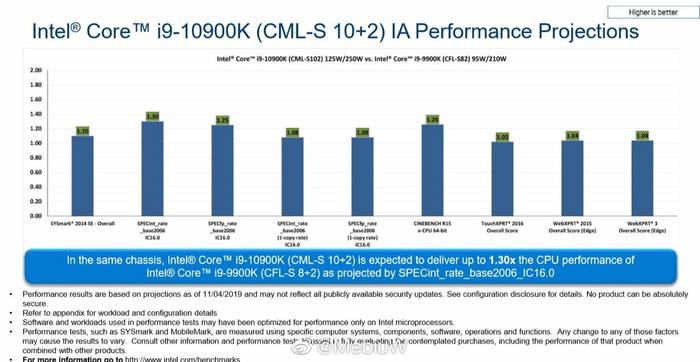At the start of the week we saw Intel's Comet Lake-S CPU offerings come into sharper view with the leak of a couple of slides tabulating the key specs and another outlining the overall plan for the upcoming SKUs. Now another interesting official looking slide has surfaced, one which provides comparison benchmarks of the current pinnacle of consumer CPU power from Intel vs the upcoming Core i9-10900K. The headline is that the new processor is up to 1.3x faster.
I've reproduced the official looking slide, above, at full size; just click it to zoom-in. As you read through the small print you will see that these test results aren't set in stone and "may not reflect all publically available security updates". It must be said that the headlining 1.3x performance of the Intel Core i9-10900K vs the i9-9900K isn't very surprising. Inter-generational improvements and tweaks to CPU architecture between Coffee Lake and Comet Lake will have been applied and the higher TDP has been implemented to drive higher clocks. However, the big change delivered to the Core i9 (CML) is two extra physical cores, moving the platform from 8C/16T to 10C/20T.
Poking through the purported benchmark results, of the nine, only three are better than 1.2x. The best result for Intel is in the SPECint_rate_base2006 IC16.0 (integer calculations) test in which the new Core i9-10900K is 30 per cent faster. In Cinebench R15 the gain is 26 per cent, and then in the SPECfp_rate_base2600 IC16.0 test (floating point calculations) the new Comet Lake chip does 25 per cent better. The remaining six tests show only a 10 per cent or weaker gain in comparative performance. Of the low-ball results it is worth noting that the XPRT tests are just 3 or 4 per cent faster and these highlight single-core processor performance.
Another little nugget of info in the slide is that the Intel Core i9-10900K will use up to 250W at all-core boost performance levels when the new Thermal Velocity Boost can come into play. Its 125W/250W power range compares to 95W/210W for its Coffee Lake predecessor.
Intel has been championing the Core i9-9000K and its variants for quite a long time as the best gaming CPUs available. It must be hoping that the Core i9-10900K has enough in the tank to maintain that halo claim until it can deliver a 10nm successor for enthusiast desktop users.
Sources: ITHome, Tom's Hardware














